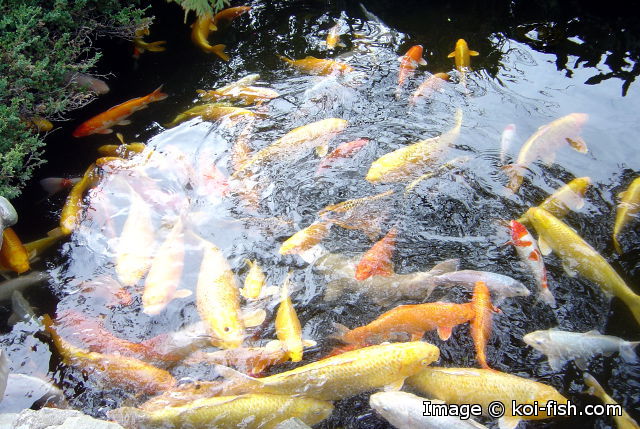Koi fish are colored carp that live in man made ponds. Keeping them as pets is can be fun and relaxing hobby.
Contents
- Koi History
- The Koi Keeping Hobby
- Your Koi’s Home
- Growing Your Collection
- Basic Care
- Sources
- Further Reading
Koi History
In Niigata, Japan, the large amount of snowfall each winter would often leave the rice farmers that lived in the mountainous region isolated for extended periods of time. They needed a source of protein during the winter season, so they would keep carp (Magoi) in a trench or unused rice paddy (the carp would have decimated the rice crop). In the fall, they would harvest and salt most of the carp fingerlings, leaving out a few to breed in the spring to replenish their stocks.
The carp were also very beneficial to the rice crop. When water was used to replenish the rice paddies, the carp waste in it made an excellent fertilizer.
Some of the carp they kept had patches of red color. We know that around the beginning of the 19th century at least one of the rice farmers took notice of this and in their spare time, began to selectively breed these unique carp in an attempt to bring out their color.1
Over the years, the Koi keeping hobby spread across Japan. Most of the people that kept Koi were well to do businessmen. The Koi were transported in wooden buckets by the breeders, who would take them from from their farm to the hobbyist’s home. There were no oxygen tanks or aerators, so the survival rate was mediocre.2
Koi keeping stayed in Japan until the early 1960’s, when polypropylene bags and jet travel allowed for quick and safe transportation all over the world.
The Koi Keeping Hobby
Advanced collectors often join a local Koi club. Koi clubs are a great resource for Koi keeping information. Hobbyists meet about once a month to share Koi care tips and any new updates for the hobby.
Some clubs host an annual Koi show. Members take their Koi from their ponds and place them into tanks to enter their fish in the show. The Koi are separated by type and size and then are judged on body conformation and color. There are winners for each type and size category, but there is only one grand champion. The owner of the grand champion receives a trophy and gets the bragging rights until the next annual Koi show.
Your Koi’s Home
Koi keepers often obsess over water quality and filtration. Koi take care of themselves (just add food) but the majority ponds that house the fish are too small to be self sustaining. They require a filter system to remove the fish waste from the pond water before it harms the Koi. A good filter system will incorporate different stages of filtration to efficiently remove each type of waste from the pond.3
Koi thrive in a stable environment. Large temperature fluctuations can easily happen in a shallow pond, so the pond itself should be at least 3 feet deep. The pond should also have steep edges that will deter predators like herons or raccoons from wading into it.
Where to Find Koi
Always quarantine any fish before adding it to your pond. Learn more about quarantining here.
There are many places that sell Koi fish. You can find them in big box retailers, mom & pop pet stores, nursery & landscaping centers, domestic Koi farms and specialty Koi shops. Big box retailers and nursery & landscape centers usually carry low grade (color) Koi in questionable tank systems. Due to the conditions the fish are kept in these places, survival rates aren't the greatest.
Pet stores and domestic Koi farms usually carry medium grade Koi fish. Koi are kept in excellent tank conditions due to the knowledgeable staff.
Specialty Koi shops usually carry medium and high grade Koi. The fish are kept in pristine conditions since the Koi that are imported are very expensive. Pond supplies and filtration equipment is often also sold at specialty Koi shops.
Basic Care
Like we stated before, Koi take care of themselves for the most part, but it is up to you to keep their pond clean and to provide the with adequate nourishment. The amount of cleaning you do is dependant on how good your filter system is. An efficient filter system will require minimal maintenance whereas a cheap and poorly designed system will require a ton of work to keep it running.
Koi are usually fed twice a day. Only give them an amount of food that they can eat within 5 minutes. They may spend most of their day begging for good, but don’t overfeed, since it can lead to poor water quality and obesity problems. Koi have different feeding requirements for each season. Read more about them here.
Koi should be minimally handled. Netting them too often stresses them out. If the fish are stressed out, their immune system becomes suppressed, making them more susceptible to bacterial infections.
Sources
- Balon, Eugene K. "The common carp, Cyprinus carpio: its wild origin, domestication in aquaculture, and selection as colored nishikigoi." (1995).
- Takeda, Kaz “History of Niigata Nishikigoi”
- Axelrod, Herbert R. “The Completely Illustrated Guide to Koi for Your Pond” TFH, (1996).
Further Reading
